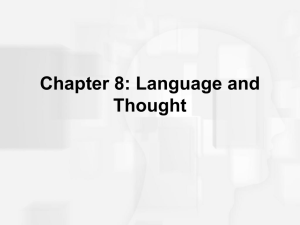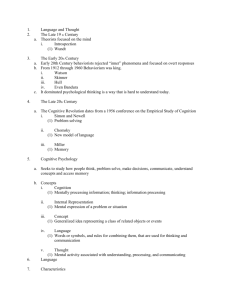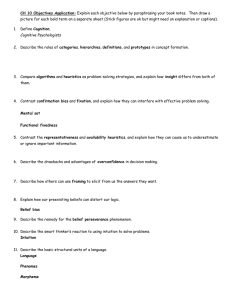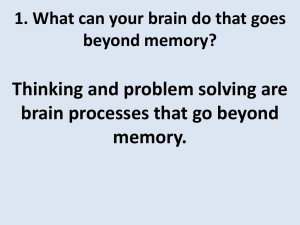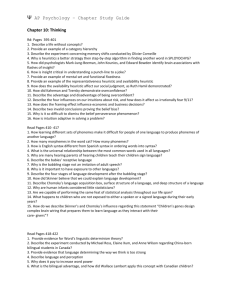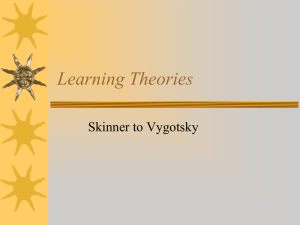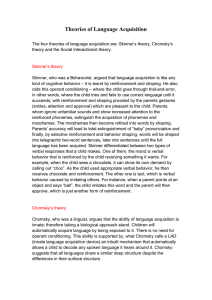Chapter 8
advertisement
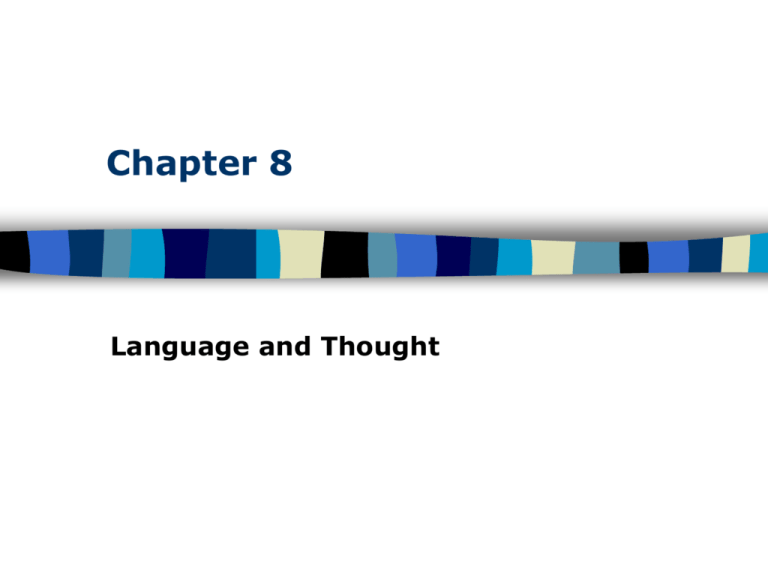
Chapter 8 Language and Thought The Cognitive Revolution 19th Century focus on the mind – Introspection Behaviorist focus on overt responses – arguments regarding incomplete picture of human functioning Empirical study of cognition – 1956 conference – Simon and Newell – problem solving – Chomsky – new model of language – Miller – memory Table of Contents Language: Turning Thoughts into Words Properties of Language – – – – Symbolic Semantic Generative Structured Table of Contents The Hierarchical Structure of Language Phonemes = smallest speech units – 100 possible, English – about 40-50 Morphemes = smallest unit of meaning – 50,000 in English, root words, prefixes, suffixes Semantics = meaning of words and word combinations – Objects and actions to which words refer Syntax = a system of rules for arranging words into sentences – Different rules for different languages Table of Contents Language Development: Milestones Initial vocalizations similar across languages – Crying, cooing, babbling 6 months – babbling sounds begin to resemble surrounding language 1 year – first word – similar cross-culturally – words for parents – receptive vs. expressive language 2 years – two words 3 years – complete sentences Table of Contents Table of Contents Language Development: Milestones Continued 18-24 months – vocabulary spurt – fast mapping - children map a word onto an underlying concept after only one exposure. – Overextentions – all balls are footballs – Underextensions – only their dog is a dog End of second year – combine words – Telegraphic speech – “Want ball”, “Give cookie” – Mean Length of Utterance (MLU) – measured in morphemes End of third year – complex ideas, plural, past tense – Overregularization • ex. ‘he goed home’ Table of Contents Bilingualism: Learning More Than One Language Research findings: – Smaller vocabularies in one language, combined vocabularies average – Higher scores for middle-class bilingual subjects on cognitive flexibility, analytical reasoning, selective attention, and metalinguistic awareness – Slight disadvantage in terms of language processing speed – Second languages more easily acquired early in life – Greater acculturation facilitates acquisition Table of Contents Table of Contents Language Development Skinner: Operant Conditioning B.F. Skinner believed that we can explain language development with familiar learning principles such as association, imitation, and reinforcement. Language is learned. Table of Contents Language Development Chomsky: Inborn Universal Grammar Noam Chomsky believes that children are biologically prepared to learn words and use grammar. Our language acquisition capacity is like a box– a “language acquisition device” (LAD) in which grammar switches are thrown as children experience their language. Table of Contents Language Linguistic Determinism Benjamin Whorf’s hypothesis that language determines the way we think The Hopi have no past tense for their verbs. Therefore, a Hopi could not so readily think about the past. Table of Contents Cognitive Theory Cognitive abilities make language development possible Children are active participants in language learning Piaget believed cognition precedes language Table of Contents Theories of Language Acquisition Interactionist - biology and experience both make important contributions. - Social communication - interpersonal communication has functional value and emphasizes the social context in which language evolves. - Emergentist theories - neural circuits supporting language are not prewired, but rather emerge gradually in response to learning experiences via incremental changes in connectionist networks. Table of Contents Table of Contents Critical Period Hypothesis Eric Lenneberg (1967) States that there is a sensitive (critical) period for language development when learning a language is easier What happens if a human misses that period? Table of Contents Can Animals Develop Language? Dolphins, sea lions, parrots, chimpanzees – Vocal apparatus issue – American Sign Language Allen and Beatrice Gardner (1969) – Chimpanzee - Washoe – 160 word vocabulary Sue Savage-Rumbaugh – Bonobo chimpanzee - Kanzi – Symbols – Receptive language – 72% of 660 requests Table of Contents Table of Contents Problem Solving: Types of Problems Greeno (1978) – three basic classes Problems of inducing structure – Series completion and analogy problems Problems of arrangement – String problem and Anagrams • Often solved through insight Problems of transformation – Hobbits and orcs problem – Water jar problem Table of Contents Table of Contents Effective Problem Solving Well defined vs. ill defined problems Barriers to effective problem solving: – – – – Irrelevant Information Functional Fixedness Mental Set Unnecessary Constraints Table of Contents Table of Contents Approaches to Problem Solving Algorithms – Systematic trial-and-error – Guaranteed solution Heuristics – Shortcuts – No guaranteed solution • • • • Forming subgoals Working backward Searching for analogies Changing the representation of a problem Table of Contents Table of Contents Decision Making: Evaluating Alternatives and Making Choices Simon (1957) – theory of bounded rationality Making Choices – Framing effect is an example of cognitive bias, in which people react differently to a particular choice depending on whether it is presented as a loss or as a gain. – Additive strategies – Elimination by aspects – Risky decision making • Expected value – what you stand to gain • Subjective utility - personal worth • Subjective probability – personal estimates of probability Table of Contents Framing Treatment A Positive "Saves 200 lives" "A 33% chance of saving all 600 people, 66% possibility of saving no one." Treatment B Negative "400 people will die" "A 33% chance that no people will die, 66% probability that all 600 will die." Treatment A was chosen by 72% of participants when it was presented with positive framing ("saves 200 lives") dropping to only 22% when the same choice was presented with negative framing ("400 people will die"). Table of Contents Table of Contents Heuristics in Judging Probabilities The availability heuristic The representativeness heuristic The tendency to ignore base rates The conjunction fallacy The alternative outcomes effect Table of Contents Table of Contents
